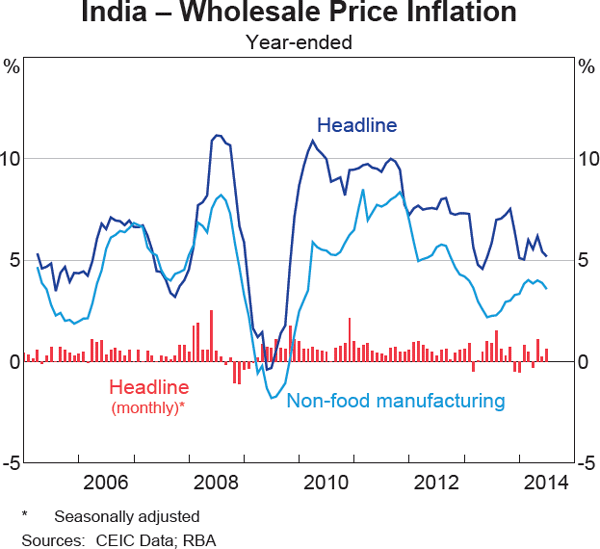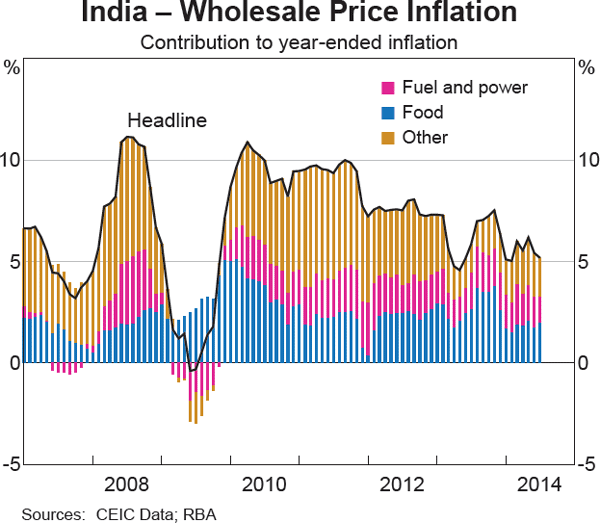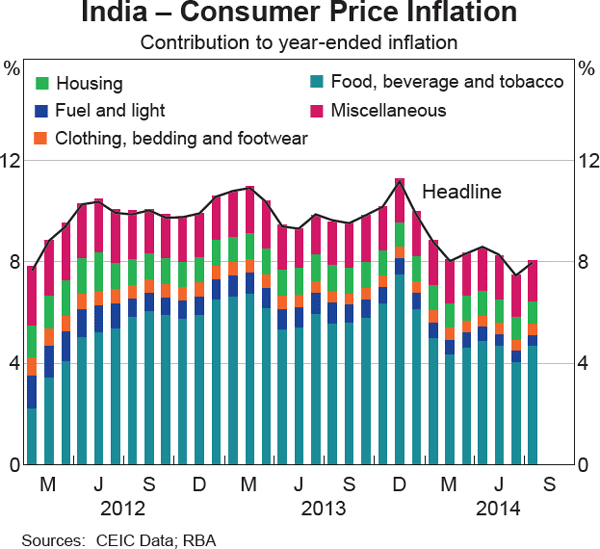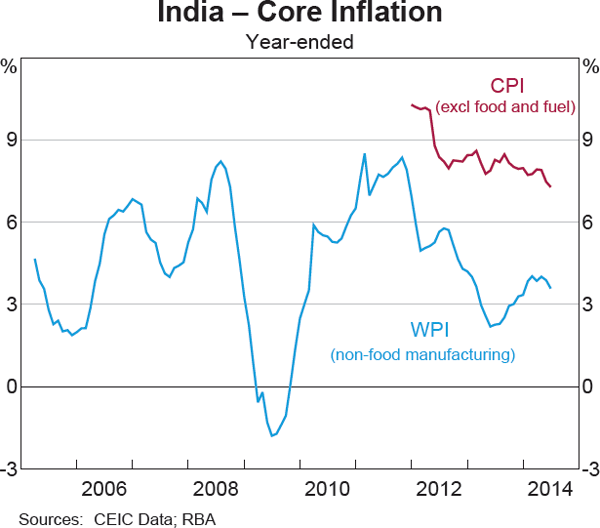Bulletin – September 2014 Global Economy Measures of Inflation in India
- Download the article 268KB
India has experienced persistently high inflation in recent years, despite a period of below-trend economic growth. As a result, controlling inflation has become a key objective for policymakers. The two main indicators of inflation in India are the wholesale price index (WPI) and the consumer price index (CPI). Although the WPI has traditionally been the most widely used measure for assessing inflationary pressures, the Reserve Bank of India (RBI) recently conducted a review of its monetary policy framework, which recommended adopting a flexible inflation-targeting regime, based on headline CPI inflation. This article outlines the two main price measures available for the Indian economy and discusses their role in India's monetary policy.
Introduction
Over the past few years, inflation in India has remained persistently high. CPI inflation was around 10 per cent up until the start of 2014 despite GDP growth declining from rates exceeding 10 per cent in 2009–10 to around 5 per cent more recently, which is below official estimates of potential growth. Accordingly, inflation has become an important focus of policymakers. On taking office in September 2013, the new RBI Governor, Dr Raghuram Rajan, highlighted the importance of ‘low and stable expectations of inflation’, and the RBI raised India's main policy rate in his first month in office. Furthermore, Dr Rajan announced a review into the RBI's monetary policy framework, led by Dr Urjit Patel (Deputy Governor of the RBI), which subsequently recommended the adoption of a flexible inflation-targeting regime based on headline consumer price inflation.[1] This contrasted with previous monetary policy statements that had focused on the WPI, and had even cited targets for WPI inflation.
The WPI and CPI are the main price indices in India. The WPI measures prices received by producers of goods, while the CPI measures prices facing consumers at the retail level. The weighting schemes, coverage of goods and the prices used are very different between the two indices, which can lead to quite different rates of inflation.
This article discusses these two price measures in detail and briefly reviews measures of ‘core’ inflation, before describing the role played by the main price measures in India's monetary policy.
Wholesale Price Index (WPI)
The WPI is produced by the Indian Ministry of Commerce and Industry. The data are collected at the first point of bulk sale in the domestic market. The prices used are ‘wholesale prices for primary articles, administered prices for fuel items and ex-factory prices for manufactured products’.[2] That is, the WPI measures the prices of products at the factory or farm gate, prior to their sale to consumers in retail markets.[3] One advantage of the WPI is that it has a long history, dating back to January 1942, which makes it useful for assessing long-term trends in inflation. The WPI also covers a broad range of goods, from raw materials to finished manufactures, but notably excludes services.
The WPI is calculated using the Laspeyres formula, which measures the change in the cost of purchasing the same basket of items in the current period as was purchased in a specified earlier period. This technique is simpler than other methods, since the weights are computed in the base period and, until this is updated, each subsequent calculation requires only an update of prices. A disadvantage of this type of index is that it will be biased if the composition of sales in the wholesale market is changing and the weights are not regularly updated. This is more likely to be an issue for a fast-changing, emerging economy such as India. As the Indian economy develops and household incomes increase, we would expect non-food items and services to account for a larger share of expenditure and the composition of production to evolve reflecting changes in demand.
The weights for components of the WPI are derived from their share of gross output in current price terms. The WPI has only been rebased four times in its history (Table 1). The weights for selected groups in the WPI changed significantly with each of the first two rebasings. Changes were relatively smaller at the latest rebasing in 2004/05. Over the past 40 years or so, a number of broad trends are apparent: the weight of primary articles (especially food) has fallen and the weight of manufactured items has increased.
Recent trends in wholesale price inflation
The headline measure of WPI inflation in India has generally remained above 5 per cent since late 2009 (Graph 1). Food items (both primary and manufactured) account for around a quarter of the WPI, and these prices can be quite volatile (Graph 2). The production of food in India is heavily influenced by the monsoon season and supply chain inefficiencies, both of which make food prices particularly susceptible to supply disruptions.[4] In addition, food prices are influenced by government policies, including subsidies and minimum support prices. They were also influenced by labour reform measures, such as the Mahatma Gandhi National Rural Employment Guarantee Act 2005, which have increased rural labour costs. In a recent speech, the RBI Governor suggested that rural wage increases had been a major contributor to higher food prices in recent years.[5]
| 1970/71 | 1981/82 | 1993/94 | 2004/05 | |
|---|---|---|---|---|
| Primary articles | 42 | 32 | 22 | 20 |
| Food | 30 | 17 | 15 | 14 |
| Non-food | 11 | 10 | 6 | 4 |
| Minerals | 1 | 5 | 1 | 2 |
| Fuel and power | 9 | 11 | 14 | 15 |
| Manufactured products | 50 | 57 | 64 | 65 |
| Food | 13 | 10 | 12 | 10 |
| Chemicals | 6 | 7 | 12 | 12 |
| Basic metals, alloys and metal products | 6 | 8 | 8 | 11 |
| Machinery and machine tools | 5 | 6 | 8 | 9 |
| Other | 20 | 26 | 24 | 24 |
|
Sources: Ministry of Commerce and Industry; RBA |
||||


Also, a report by the Institution of Mechanical Engineers (2013) estimates that at least 40 per cent of India's fruit and vegetables are lost between the grower and consumer. Consistent with that, the International Monetary Fund highlights the need for agriculture reforms that reduce administrative inefficiencies in food distribution, pricing and storage, and boost productivity in agricultural production in its Article IV consultation (IMF 2014). A significant depreciation of the rupee in the first half of 2013 has also contributed to elevated WPI inflation over the past year and a half. Over 2014 to date, WPI inflation has moderated, consistent with a good harvest at the end of 2013 and the effects of relatively tight monetary policy.
The non-food components of WPI inflation are less affected by supply-side influences affecting food prices and are consequently less volatile than headline inflation. The fuel and power component – which accounts for 15 per cent of the WPI – has been relatively stable since 2010, although it had shown more volatility in previous years. Prices in this sector are affected by government subsidies for fuel and administered prices (e.g. utilities prices). Although they receive a smaller weighting in the index than food prices, the prices of non-food primary articles and minerals also contribute to the volatility of inflation, since these components are affected by fluctuations in global commodity prices.
Consumer Price Index (CPI)
An alternative gauge of price movements in India is provided by the CPI. As discussed below, a recent report to the RBI Governor by the Expert Committee to Revise and Strengthen the Monetary Policy Framework (the Patel Committee) recommended that the RBI adopt a flexible inflation-targeting regime with headline consumer price inflation as the target.
Two different government agencies, namely the Ministry of Statistics and Programme Implementation (MOSPI) and the Ministry of Labour and Employment, publish a number of consumer price indices (Table 2). Each index has its own set of weights and the base period used varies across measures. There are also methodological differences between the indices, such as the way in which prices are collected.
The urban, rural and combined CPIs produced by MOSPI have been published since 2011. In contrast, the measures of consumer price inflation computed by the Ministry of Labour and Employment have a much longer history; the time series of the CPI for industrial workers began in 1989. Although these indices have been used in wage determination and as a reference for the provision of welfare benefits, they use base period weights that are substantially out of date, and are unlikely to reflect the current Indian household consumption basket.[6] Moreover, the RBI has expressed a preference for the MOSPI CPIs. For these reasons, the rest of this article focuses on the recently developed urban, rural and combined CPIs produced by MOSPI.
| Ministry of Statistics and Programme Implementation | Ministry of Labour and Employment |
|---|---|
| Urban CPI | CPI – rural labourers |
| Rural CPI | CPI – agricultural labourers |
| Combined (urban and rural) CPI | CPI – industrial labourers |
| CPI – urban non-manual employees (ceased in 2011) | |
|
Sources: Ministry of Labour and Employment; Ministry of Statistics and Programme Implementation |
|
Since these CPIs have only been published for a short period, reliable seasonal adjustment is not feasible.[7] This is problematic, as the monthly growth rates are likely to exhibit a notable seasonal pattern. In addition, these CPIs are relatively new in their current formulation and may undergo substantial changes as the calculation methodology is refined. Nonetheless, the combined CPI has become the main focus of policymakers, and the Patel Committee has recommended that the RBI focus on this measure in its deliberations about monetary policy.
The weights for the components of the combined CPI (hereafter referred to as ‘the CPI’) are calculated using data from the 2004/05 consumer expenditure survey conducted by the National Sample Survey Office. The most recent consumer expenditure survey was conducted over the year to June 2012, and the CPI is scheduled to be reweighted in 2014 to reflect these data. The headline CPI is compiled by weighting together state-level CPIs. The Patel Committee observed that this may make headline inflation quite sensitive to localised price growth and volatility, and suggested that compiling the CPI using national level weights for each commodity-level component might be preferable. Like the WPI, the CPI is calculated using a Laspeyres formula, so it has the same problems mentioned above whenever consumption baskets are changing relatively quickly.
The CPI places a much larger weight on food items than the WPI, since it is weighted on the basis of household expenditure. Food, beverages and tobacco have a combined weight of nearly 50 per cent (compared with around 25 per cent in the WPI). Also, the CPI includes components such as services (classified under the ‘miscellaneous’ category) and housing, which are notable omissions from the WPI.
Recent trends in consumer price inflation
Consumer prices in India have been growing rapidly over the past two years, and at a much faster pace than wholesale prices (Graph 3). The substantially larger weight on food items in the CPI, as well as the inclusion of services prices, account for a large part of the difference between the rates of CPI and WPI inflation. Food items made a significant contribution to consumer price inflation over recent years, and also accounted for most of the volatility in consumer prices, with inflation remaining relatively stable for the other major components (Graph 4). While services have a smaller weight than food, the prices of services (e.g. education, medical and transport prices included in the ‘miscellaneous’ category) have been growing rapidly in recent years. In addition, the housing component has been growing at around 10 per cent since 2012, also a faster pace than overall CPI inflation.


Measures of Core Inflation
India does not publish an official measure of ‘core’ (or ‘underlying’) inflation, although such measures can be useful as an indication of underlying trends in economy-wide price pressures. In a 2011 occasional paper, the RBI assessed a number of alternative measures of core inflation and found that the ‘non-food manufacturing’ component of the WPI was the most suitable series.[8] Non-food manufacturing inflation is not published, although it can be estimated using the published WPI indices and weights. While headline WPI inflation and non-food manufacturing inflation have both trended lower since 2011, non-food manufacturing inflation has fallen to much lower rates (Graph 5). This may indicate a degree of downward pressure on inflation consistent with slow growth in industrial production and economic demand more generally. The RBI estimates that potential growth has slowed from around 8 per cent prior to the global financial crisis, to about 6 per cent at the end of 2013 (Reserve Bank of India 2014b). This implies that GDP (at factor cost) has been growing at about 1–2 percentage points below potential, in year-ended terms, for the past two years.

A measure of core CPI inflation can be compiled by excluding the food and fuel components. However, this only leaves around 40 per cent of the consumption basket, making it a rather narrow measure of consumer price inflation. A further drawback is that, according to the RBI's estimates, shocks to the food and fuel components have larger and longer-lasting effects on inflation expectations than shocks to the other components.[9] A measure of core inflation that has a weak relationship with inflation expectations may be of limited usefulness for policymakers.
In general, the ‘core’ CPI and WPI measures have been less volatile than headline inflation over the past couple of years. The rate of core inflation, as indicated by the non-food manufacturing component of the WPI, has fallen to well below that of the headline rate. While the measure of core CPI inflation has also generally been below headline CPI inflation since 2012, it has remained at a high level.
The Role of Inflation in India's Monetary Policy
The WPI has been the main measure of inflation monitored by policymakers in India for several years, but the CPI is now assuming a more important role as the more widely consulted measure. In general, this shift reflects the fact that the WPI is not an ideal measure of inflation from the point of view of monetary policy.
In recommending that the RBI target headline CPI inflation, the Patel Committee cited a number of reasons. First, the fact that prices in the wholesale market are not purely producer prices or consumer prices makes the WPI difficult to interpret. Indeed, to the extent that there are significant variations in retailer mark-ups, wholesale prices may not provide a reliable gauge of aggregate inflation.[10] Second, the WPI does not capture movements in the prices of services, which constitute about 60 per cent of gross value added in the Indian economy. Third, the use of the CPI in wage contracts and negotiations, and as a reference for the provision of welfare benefits, means that it is relatively well known to the public and therefore more likely than wholesale prices to guide the formation of inflation expectations of workers and consumers. Finally, as it provides a measure of the cost of living, the CPI more appropriately captures the welfare implications of price changes.
The Patel Committee proposed the adoption of a target rate of consumer price inflation of 4 per cent (+/–2 per cent) over a two-year horizon, largely on the basis of empirical evidence suggesting that inflation above 6.2 per cent was harmful to growth and the observation that, historically, estimates of the output gap had been close to zero during periods when average CPI inflation had been around 4 per cent. It also drew on the experiences of inflation-targeting emerging economies, including those documented by Jonas and Mishkin (2003). However, India's rate of consumer price inflation is currently over 7 per cent, which is well above the target rate of 4 per cent, so the Patel Committee has recommended targeting a gradual reduction in inflation over the next two years (referred to as the ‘glide path’). Specifically, it recommends targeting 8 per cent inflation by the start of 2015, 6 per cent inflation by the start of 2016, and formally adopting the 4 per cent target thereafter.
In its ‘First Bi-monthly Monetary Policy Statement 2014–15’, the RBI announced the official adoption of the CPI as its key measure of inflation (Reserve Bank of India 2014a). In the same statement, the RBI also adopted the ‘glide path’ for inflation recommended by the Patel Committee, although no announcement about adopting a formal inflation target has been made to date.
Footnotes
The author completed this work in Economic Group. [*]
For the full report, see Reserve Bank of India (2014c). [1]
See Kumar and Boopathy (2013, p 1). [2]
As Reserve Bank of India (2014c) notes, this is not true for all items in the index, with prices for some important items such as milk being sourced from retail markets. [3]
For further information, see Cagliarini and Rush (2011). [4]
See Rajan (2014). [5]
See Kumar and Boopathy (2013, p 20) for a comparison of the different CPIs. [6]
The Reserve Bank of India (2014c) suggests that a CPI with a longer time series could be constructed by applying the weighting pattern of the combined CPI to component indices of the CPI for industrial labourers. The weighting pattern needs to be applied at as high a level of disaggregation as possible, but only broad group indices are publicly available for the CPI for industrial workers. [7]
See Raj and Misra (2011) for further information. [8]
The Reserve Bank of India (2014c) estimates that a 100 basis point positive shock to food inflation immediately raises one-year-ahead household inflation expectations by 50 basis points and that the effect of the shock persists for eight quarters. The effects of shocks to fuel prices are also large, but less persistent, lasting for around four quarters. [9]
Reserve Bank of India (2014c) also notes that the CPI is typically subject to fewer revisions than the WPI, which enhances the practical usefulness of the CPI as a measure of inflation both for the public and for monetary policy purposes. [10]
References
Cagliarini A and A Rush (2011), ‘Economic Development and Agriculture in India’, RBA Bulletin, June, pp 15–22.
Institution of Mechanical Engineers (2013), ‘Global Food: Waste Not, Want Not’. Available at <http://www.imeche.org/docs/default-source/reports/Global_Food_Report.pdf?sfvrsn=0>.
International Monetary Fund (2014), ‘India: 2014 Article IV Consultation’, IMF Country Report No 14/57.
Jonas J and FS Mishkin (2003), ‘Inflation Targeting in Transition Countries: Experience and Prospects’, NBER Working Papers No 9667.
Kumar A and GM Boopathy (2013), ‘National Price Indices and Inflation During 2012’, Ministry of Statistics and Programme Implementation. Available at <http://mospi.nic.in/Mospi_New/upload/price_stat_8mar13.pdf?status=1&menu_id=215>.
Ministry of Statistics and Programme Implementation of India (2010), ‘Manual on Consumer Price Index’. Available at <http://mospi.nic.in/Mospi_New/upload/manual_cpi_2010.pdf>.
Raj J and S Misra (2011), ‘Measures of Core Inflation in India – An Empirical Evaluation’, RBI Working Paper Series No 16/2011.
Rajan R (2014), ‘Fighting Inflation’, Inaugural Speech at the 15th FIMMDA PDAI Annual Conference 2014, Mumbai, 26 February.
Reserve Bank of India (2013), ‘First Quarter Review of Monetary Policy 2013–14’, 30 July.
Reserve Bank of India (2014a), ‘First Bi-monthly Monetary Policy Statement, 2014–15’, Press Release 2013-2014/1925, 1 April.
Reserve Bank of India (2014b), ‘Macroeconomic and Monetary Developments 2014–15 (An Update)’, 1 April.
Reserve Bank of India (2014c), ‘Report of the Expert Committee to Revise and Strengthen the Monetary Policy Framework’, January.